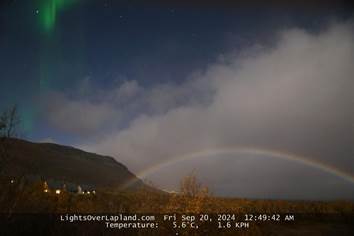At 00:50 this morning (Friday 20th September), Aurora photographer Chad Blakely, founder of Lights Over Lapland, photographed one of the rarest events in the Arctic, as a ‘moonbow’ and the Northern Lights came together in an extraordinary natural event.
This visual spectacle is dependent upon very specific weather, atmospheric and astronomical conditions, which need to align perfectly – making it one of the rarest sights in the night sky.
It was spotted above Abisko National Park in Northern Sweden, widely regarded as one of the best places in the world for Northern Lights hunters due to local weather conditions. The event was last seen in 2018 to the amazement of locals and experts.
Chad Blakely, the Lights Over Lapland photographer, who captured the image, said: “We are currently in Solar Maximum, a period of intense solar activity that causes more frequent and brighter aurora displays.
“This combined with humid conditions and a nearly full moon resulted in this unbelievable display.
“We would have very likely missed it had we not checked our Aurora webcam, something we set up in 2013 to give Aurora fans a live feed of images of the night sky, and Northern Lights, over Abisko.”
Moonbows are caused in the same way as a rainbow, however instead of light from the sun refracting through water droplets, it is caused by luminescent moonlight.
According to the MET office, “Moonbows were first mentioned by Aristotle back in 350BC, and there are certain parts of the world where you are more likely to see them, such as Hawaii.”
However, the bright light from the moon is not conducive to experiencing the Northern Lights, again, adding to the rarity of the event captured this morning.
The Northern Lights are caused in a very different way. Chad explains; “The Aurora Borealis is caused by charged particles from the Sun interacting with Earth’s magnetic field.
“There is a constant flow of these charged particles, however during stronger storms they enter the atmosphere and collide with gas particles, including hydrogen and helium.
“As a result of this collision, energy is released in the form of light.”
Auroral displays appear in many colours although pale green and pink are common.
Chad adds; “For anyone dreaming of experiencing the Northern Lights we cannot guarantee such a rare event like the one we have just witnessed; however, we would recommend heading north to somewhere in Northern Scandinavia.
“We are currently at the height of the Solar Maximum which marks the pest possible time to visit the region to see the lights, however as you need clear dark skies the winter months, with longer, darker nights, is always recommended.
“Then it is a case of being patient and enjoying beautiful Arctic nature as you wait for the best natural light show on Earth.”
To find out more about experiencing the Northern Lights, visit https://lightsoverlapland.com/ or to see what is going on in the Arctic right now visit https://lightsoverlapland.com/aurora-webcam/
